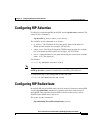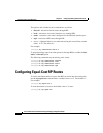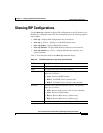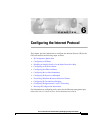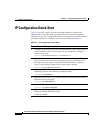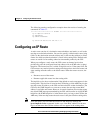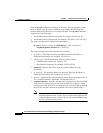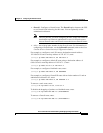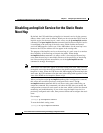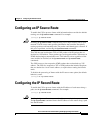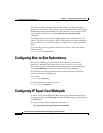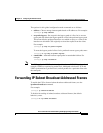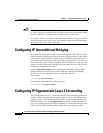
6-3
Cisco Content Services Switch Routing and Bridging Configuration Guide
OL-4580-01
Chapter 6 Configuring the Internet Protocol
Configuring an IP Route
The following running-configuration example shows the results of entering the
commands in Table 6-1.
!*************************** GLOBAL ***************************
ip no-implicit-service
ip redundancy
ip subnet-broadcast
ip route 192.168.0.0/16 192.167.1.1 1
Configuring an IP Route
A static route consists of a destination network address and mask, as well as the
next hop to reach the destination. You can also specify a default static route (using
0.0.0.0 as the destination network address and a valid next hop address) to direct
frames for which no other destination is listed in the routing table. Default static
routes are useful for forwarding otherwise unrouteable packets by the CSS.
When you configure a static route, the CSS creates an internal service that
periodically polls the configured next hop address with an ICMP echo (or ping)
keepalive. The internal service is called an implicit service. If the router fails, the
CSS removes any entries from the routing table that point to the failed router and
stops sending network traffic to the failed router. When the router recovers, the
CSS:
• Becomes aware of the router
• Reenters applicable routes into the routing table
The implicit service does not determine if the default or static route appears in the
routing table. This decision is based on the CSS having a viable ARP entry for the
next hop router IP address so the CSS can forward traffic to that destination. The
CSS uses the ICMP keepalive as a means to ensure the next hop router MAC
address is available and current. However, in certain situations, the next hop router
may block ICMP message transmitted by the CSS, which results in a failed ICMP
keepalive (the ICMP keepalive is in the Down state). As long as the CSS has the
ARP entry of the next hop router the static route is still placed in the routing table.
Note The CSS allows you to disable the internal ICMP keepalive through the
ip-no-implicit service command. In this case, if the MAC address for the next
hop is not known to the CSS the address will not appear in the routing table.



